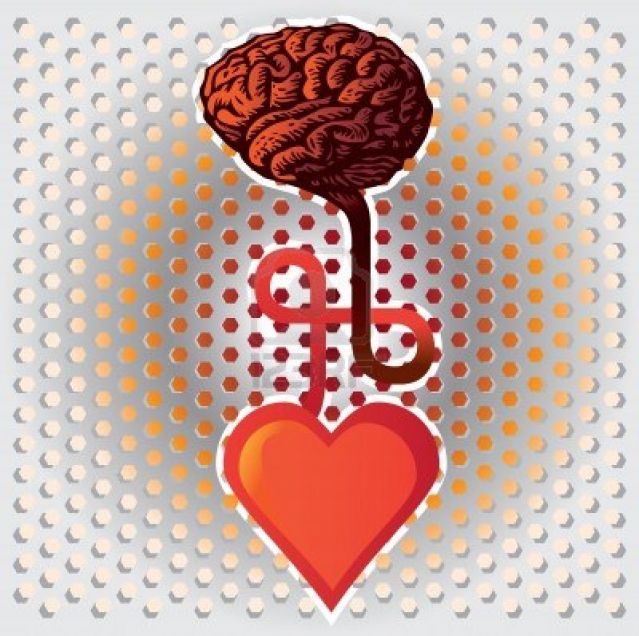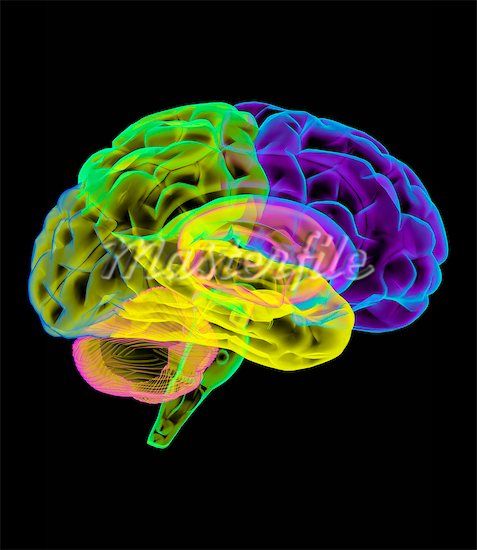Motivation
Are You a Teacher Not Ready for School to Start?
If going back to school holds a bit of dread make an animoto.
Posted August 19, 2012
School is Starting. If you are still “burned out,” your brain has rewired to survival mode—go make a “Animoto” video. Its easy, you’ll find your inner videographer, and make a powerful impact on your students. AND YOU WILL ALL HAVE MORE joyful learning.

Where heart meets brain there is joyful learning
If going back to school as the teacher has got you feeling that the summer went way too fast and you didn't get to read all those books you hoped would have the key to classroom management, you might feel like the person in this cartoon.
My belief is that when you understand what happened in your brain to build up the hopelessness frustration of burnout, you’ll connect with the logic of the interventions. Then with the addition of the video game model to the boost the neurochemical benefits of the activity of your choice, you’ll literally deconstruct the resistance network your brain constructed and reset your circuits of confidence and motivation.

You are not Alone
Teachers often blame their personal inadequacies for problematic student behavior, failure to “cover” every standard, and for not differentiating instruction to suit the needs of each student. Know that you are not alone, but part of a growing majority of educators questioning their abilities to continue teaching. You are teaching at a time when it takes profound commitment and creativity to strive to meet expectations. There is pressure to teach excessive quantities of information and differentiate instruction to meet the needs of all students, yet the supporting resources needed are dwindling.
Burnout feelings are not a reflection of your teaching skills. Teachers who question their ability to do their jobs properly are often among those who hold themselves to the highest standards and put in the greatest effort. When they are pitted against external forces, beyond their control, that limit attainment of the expectations they hold for themselves, self-doubt builds, confidence drops, and burnout sets in.

If You’re Burned Out, Your Brain Has Rewired to Survival Mode
What I offer from the nexus of my duel careers as a neurologist and classroom teacher are interpretations and correlations from the neuroscience research to teaching and learning. Neuroimaging studies reveal the metabolic changes in regions of the brain that increase or decrease in activity in response to emotional or sensory input.
There are specific and reproducible patterns of changing neural activity and brain structures associated with stress. In the high stress state subjects scans reveal less activity in the higher, reflective brain and more activity in the lower, reactive brain that directs involuntary behaviors and emotional responses. Prolonged stress correlates with structural increases in the density and speed of the neuron-to-neuron connections in the emotion-driven reactive networks of the lower brain and corresponding decreases connections in prefrontal cortex conscious control centers.
The explanation of these changes is generally attributed to the brain’s neuroplasticity of “neurons that fire together, wire together”. The brain literally rewires to be more efficient in conducting information through the circuits that are most frequently activated.
As your thwarted efforts to achieve your goals were internalized and interpreted as personal failure, your self-doubt and stress activated and strengthened your brain’s involuntary, reactive neural networks. As these circuits become the automatic go-to networks, the brain is less successful in problem solving and emotional control. When problems arise that previously would have been evaluated by the higher brain’s reasoning, the dominant networks in the lower brain usurp control.
Reset Your Brain’s Default Neural Network from Retreat to IGNITE!

The good news is you can apply what you now understand about your brain’s survival mode to take actions to take back voluntary control of your choices. You can activate the same neuroplasticity that gave dominance to the lower brain networks in the burnout state to construct a new, stronger default response. With more successful experiences achieving goals, you can reset the circuits that will direct your brain to access its highest cognitive resources for creative problem solving. You can build up new improved circuitry switching your responses from retreat to IGNITE!
Since an effort-failure pattern set up the brain’s survival response to withhold effort, you’ll need to strengthen the pattern of effort toward your goals can result in success. Your weapon of mass reconstruction can come from your brain’s very powerful drive for its own neurochemical — dopamine and the pleasure it brings.
The plan to guide you comes from the video game model that works because of three components: buy in, achievable challenges, and frequent awareness of incremental goal progress on route to the final goal.
For a full description of the video game model you can link to my two Edutopia blogs and video that also include strategies use applying the model to teaching.
- A Neurologist Makes the Case for the Video Game Model as a Learning Tool
- How to Plan Instruction Using the Video Game Model
The fuel that motivates the brain to persevere through increasing challenge even through failed attempts is dopamine. This neurochemical, produces the pleasure of if intrinsic satisfaction and increases motivation, curiosity, perseverance, and memory. Dopamine is released when the brain makes a prediction or achieves a challenge (from the “I get it” of figuring out a joke to the satisfaction of completing a marathon) and gets the feedback that it was correct.
Just as the video game model can be applied to building a growth mindset in students, the same model can help rewire your mindset regarding your ability to achieve teaching goals at school. As in the video game model, to get the dopamine-pleasure response from challenges achieved, you’ll need to plan for your brain to experience frequent recognition feedback of incremental progress. The choices of what you set as a goal should be guided by their desirability and the goal’s suitability to be broken down into clear segments such that you can chart as your goal progress as you achieve each stepwise challenge. The pleasure burst of intrinsic motivation that will accompany your recognition of each progressive increment achieved in the goal pathway will keep your brain motivated to persevere.
Goal Buy-In for Your Brain’s Neural REWIRING
Buy-in and relevance are important in choosing your rewiring goal. Since your goal is to rewire your brain’s expectations that your goal efforts do yield progress, even through increasing challenge, you need to really want the goal. This is not the time to challenge yourself with something you feel you should do, but won’t really look forward to, such as dieting, climbing stadium stairs, or flossing after every meal.
Select a goal that you would enjoy on route and at the finish.
Usually goals are tangible (visible, such as planting a garden or making pottery on a wheel, or auditory such as playing an instrument, or physical (learning tai chi), but your goal can also be increased amount of time you sustain an activity such as journaling, practicing yoga, or sketching.
You’ll Find Your Own Goal for Buy-In, but Here Are Some Examples of Planning
Physical goals: notice I didn’t say exercise. That’s not as motivating as “training” for a physical goal you want to achieve, even though they often overlap. If you want to run a 10K, and you enjoy running, the goal for achievable challenge could first be building up to the distance starting with your baseline distance you comfortably run now. Then plot out the increments that you’ll consider progressive successes such as adding .5K a day or a week – the increments will depend on what you consider both challenging and achievable. Once you reach 10K, speed can become the next goal again plotted out in segments of incremental progress before you start.
Archery: Possibly after seeing Hunger Games archery has new appeal. Again, plan your stepwise achievable challenge increments. Start with a home dartboard – low initial investment and throw from a close, but challenging distance at first. As you get better in accuracy move back further. Record your results with the notations of the distance of each improvement you set as an achievable challenge. If you get so good that you are no longer challenged by the dartboard, try that archery!
Learn a language — only if the buy-in strong enough, such as definite plans to go to a country where the language is spoken.
Try Meeting Students on Their Turf
Videography: If it appeals to you to make high quality videos or powerpoints using advanced computer software, go for an early success such as the videos you can make on animoto.com (or lots more of video-techy "productions" you can make free online using software that make your words and questions come from avitars or in comix).
As you use these tools to make video or animated "clips" to engage students in new topics, students will more than meet you half way. You are putting effort into a represenation of information they feel comfortable with. As a result they find the topic more relatable and as you share a blog, wiki, or make animotos with them, a new positive dynamic may build up.
Animoto: http://animoto.com/education Free EDUCATOR “Plus” Account
Or about 30 choices for the amature avatar or video designer (and I mean NO previous experience) on the website for Connect, Collaborate, and Create: http://hccweb2.org/web2/
I’ll put my first and second “animotos” into this article.
I’ll put my first and second “animotos” into this article. First is called RADTeach.com “Neuroplasticity lesson advertisement for curiosity video.mov” with YouTube link https://www.youtube.com/zxWlnIs2m7Q
The first took me about 30 minutes to learn the system, the second took about 10 minutes because I got some images from google image and put them on my desktop to just drag into the animoto system…you’ll see. It is called Dopamine Fixes Brain Mistakes https://www.youtube.com/EEi3VXNmnjo
Students who had done poorly in your subject see you in a new way when you incorporate the technology they enjoy in their learning and assessment. Choose these creative online websites so there are choices, and let students choose their mode of representation while you make clear the expectations for the information they need to represent in their production. For many, this experience to demonstrate understanding through a medium they know and with which they are familiar is a chance to do something they can enjoy and be recognized for doing it well.
The video format may be their initial motivation for doing their homework on time and really getting something from doing it. This may be the first reason they actually do their homework with the desire to do a good job. But that inroad is a powerful one for students who've always felt the out of control because they believed their teachers held all the information and made the rules. These students were not very confident that they understood their teacher's expectations, explanations, or suggestions (if any were even given). Students in these fixed mindsets not only withhold effort, but they also start blaming teachers as if they are withholding information, not telling "what to study for the test", and then judging them on tests that ask all the things they don't no. The battles escalate and communication suffers.
As you return to school with more common ground and plans to incorporate more online tools as interactive, informal, formative assessments, you may find the year gets off to a powerful start. With ongoing, formative assessment that will be available when you incorporate even the simple video-making homework for students to express their understanding of a few pages read for homework in a video clip, students will have a renewed sense of optimism, and appreciation.
Your "return" on learning to work with teaching technology that students feel good about, even if it is somewhat out of your comfort zone, will be rewarded by their increased perseverance, class participation, and the questions the will now ask about the topic, because, to improve the accuracy of the characterization or other aspects of their video representations, they will ask questions about the material. For the first time, they WANT to know what you HAVE to teach.
Now with free, engaging technology, as students use the tools they like, and the skills they have honed, the actual application of these positive mood boosters will carry over the dopamine-reward response, as they build more resilience, greater perserverance to inceasing challenge, and more engagement in class. The "zone out" and "act outs" of last year will be replaced by students working with you as a guide as they now are experiencing the benefits of the math you have to teach them and how it will improve the qualities they are seeking to represent in their video model.
Before school starts, or as a surprise after the first weekend, go on to the website and put some of your summer photos on your desktop, you'll see how easy it is to just click a few into the spaces and the animoto does the rest as your images take on the professional look with transitions, music, and great special effects. Remember, just as they appreciate your trying, your creation does not have to ready for MTV, just ready to show your students you cared.
Your Rewired Brain’s Default Changes from Defeat to Ignite
The repeated experiences of dopamine-reward you’ll experience will literally change your brain’s circuitry. Repeated effort-reward experiences promote the neuroplasticity that make neural network that expects positive outcomes your new default network. This is because your brain built stronger and more connections into the memory pattern that effort toward an achievable challenge brings pleasure. As with other networks not used, the previous lower brain stress- activated go-to response network you developed that caused you to react to problems will be pruned away from disuse.
You’ll be rewired with optimism and renew your positive expectations. With your higher, reflective brain back in control, you’ll be able to access your perseverance, innovation, and creative problem solving when you return to the classroom.

Just be sure to take the time to recognize each small success and creative problem solving. Keep up the habit of breaking down big challenges into opportunities to recognize incremental progress and receive your well deserved dopamine reward. The brain needs that battery recharge to sustain the positive expectations that motivate continued effort to the next step up on route to your teaching goals.




